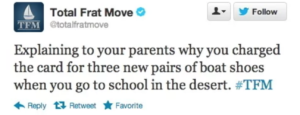Disclosure: I may earn affiliate revenue or commissions if you purchase products from links on my website. The prospect of compensation does not influence what I write about or how my posts are structured. The vast majority of articles on my website do not contain any affiliate links.
About 8 years ago, there was a proliferation of websites featuring short anecdotes punctuated by an acronym. You may remember TFLN and FML. It turns out that the popularity of these sites is what inspired the first iteration of TFM–Total Frat Move. At least, so says this article from 2014.
Total Frat Move couldn’t have arrived at a more perfect time. Twitter-like (microblogging) websites were gaining in popularity. Greek life (generally speaking–bro culture) was beginning to penetrate the mainstream. College students had no college-centric websites where they could congregate. Maybe College Humor could have been considered the leading platform for college-aged humorists, but nobody really saw it that way.
The concept behind TFM at its 2010 launch was simple. The main page had a “wall” listing Total Frat Moves that were user-submitted. My high school friends and I found them hilarious despite, well, not being in frats.

We shared them, recited them from memory, and, to some extent, imagined one day embodying them. The site was officially pegged as satire but the distinction has always been blurred. For the first few years after launch, TFM was a major success. Several spinoff websites were created, the Rowdy Gentleman clothing brand was founded, and viewership soared.
They even published a book, which was not bad!
College students involved in Greek Life found the material funny and poignant. High school kids began to get exposed to the “culture” before they made it to college. Tempted by party scene rankings and video montages like I’m Shmacked, students were entering college with unprecedented knowledge of what it meant to “Go Greek” as well as larger-than-life expectations. If you looked at participation numbers in Greek Life for the period between 2010-2015 versus 2005-2010, you would notice an uptick. TFM played a large part in Greek Life becoming a front-and-center feature of pop culture into the 2010s. “Frattiness” became an objective measure of how well one was assimilated into the Greek Life subculture, while “frat” quickly became a pejorative.
Along with branching out, the site added editorials and other user-generated content streams, such as pictures of attractive college-aged women, a video section, and Fail Friday, which curated the most hilariously-bad fraternity-related fails. As freely as risque images and videos may have been shared in the early years (which were tame compared to rival-turned-sellout Southern Fraternity community Old Row), controversy mounted.
While the site reached its pinnacle around 2013, Greek Life across the country was under siege. The relationship between those who were a part of Greek Life, those who weren’t, and school administrations became increasingly strained. In this case, a legion of students spanning roughly 8 graduation years was under the influence of the site with the cute sailboat logo. The stupidest among them saw nothing wrong with Snapchatting photos and videos of themselves doing dangerous, illegal things in their chapter houses. Sometimes even submitting it to TFM–the content had to come from somewhere. Stereotypes were built and enforced by a small, over-enthusiastic group. Things often went too far in the name of one-upmanship.
With tangible–digital–proof of some of the things that were going on, student groups had the ammunition they needed to fight back. In most cases, there weren’t pending criminal charges but schools were quick to side against fraternities and sororities, as there is really no upside to protecting them aside from appeasing affiliated donors and upholding certain constitutional protections which are only afforded to those at public schools. Greek Life would go on to be ripped to shreds on campuses across the US while the website that many considered the embodiment of the subculture ironically became the central repository of material that was drastically turning public opinion against its constituents.
Flaws in the business model became exposed. TFM was originally much more popular than Barstool Sports, The Chive, and other sites appealing to the “twenty-something male” demographic. However, these sites diversified faster, hired better, and produced superior content. People congregated on alternative sites because being a college student in a fraternity or sorority was a central part of TFM, and visitors who weren’t affiliated felt alienated. Die-hards felt betrayed because the forums were closed, comments were moderated more closely (to be fair, content that was overtly racist and sexist), and the “wall” on the main page which the site was famous for was removed completely.
People who graduate college tend to not care about what’s happening on campus. Grandex, TFM’s parent company, realized this and started another project called Post-Grad Problems (PGP), which actually did achieve some measure of success. Most who remember the original site will have no idea that this spinoff exists. It’s a cool community with a dedicated readership but never popped the same way TFM did. To be clear, it’s popular and active but is nowhere near as pervasive. This new website made clear a problem with producing content for the college demographic: talented college writers who want to write about Greek Life for “pretty much beer money” are few and far between. Some readers moved to PGP, where the writing was better and the content was naturally more diverse. But that’s being kind. The entire demographic was swallowed by Barstool.
Almost two years ago, TFM published an article called “Here’s What’s Going On“. In short, they admitted that their content strategy–trying to diversify–had failed and that the site was having trouble. It was insinuated that the ad revenue generated was dwarfed by what was generated by the Rowdy Gentleman clothing brand. Many old commentators (who had to be years out of college at this point) paid their last respects and talked about moving on.
About a month ago, PGP announced that the employee who wrote that post (and was the de facto spokesman of the brand) had been laid off. The post mentioned drastic changes. As of early December, the TFM website wasn’t functioning properly. As of today, it still isn’t functioning and there hasn’t been any new content.
In the age we live in, things move pretty fast. I had a wonderful college experience that was partially influenced by TFM. I visited it in high school, regularly perused it throughout college, and even purchased the TFM book. Every few months after graduation, I would still return to the site. I still couldn’t tell you what I was looking for.
Now, it’s come time to pay respects. In 2019, it’s easy to poke fun at frat boy humor and just as reflexive to celebrate its downfall. The fact of the matter is that Total Frat Move was a culturally-significant website. Ironically, as it popularized the subculture, it was partially responsible for the mainstream vilification. I will never forget the sense of belonging it instilled in me as a far–far left-field fraternity member. Maybe Greek Life really is just a story of us versus them, but it’s ignorant to deride a website that at its core just brought people together to share a few laughs. And on behalf of those who haven’t yet figured out whether they’re us or whether they’re them, I thank everyone at Total Frat Move for keeping a smile on my face during the most formative time of my life.




